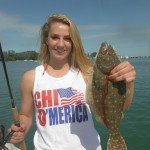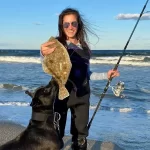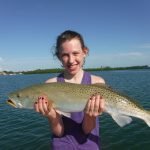Surf Fishing for Flounder and Fluke
This article will thoroughly cover surf fishing for flounder and fluke. Flounder and fluke are prized by anglers surf fishing. They put up a decent tussle and are fantastic eating!
The first thing I want to do is clarify the terms “flounder” and “fluke”. Southern Gulf flounder are the prevalent flounder species in the south. Fluke are similar up north. Both have large mouths full of teeth. They are very similar in habits and will be covered together.
Winter flounder are a completely different species. They have smaller mouths and behave quite differently. Not very many winter flounder are caught by anglers surf fishing. Flounder and fluke begin their life swimming normally, then convert to swimming on their side. The eye migrates around. Both fluke and southern Gulf flounder have the eyes on the left side, winter flounder have them on the right side.
Surf fishing for flounder and fluke
The most important factor when surf fishing for flounder and fluke is to understand the habits of the fish. Tied into that is reading the beach. Flounder, more than most surf species, are found in very specific spots. They are ambush predators that bury in the sand and attack prey as the tide brings it close by.
Flounder in the surf are most often found in the first trough closest to shore and in cuts in the bars. These are natural feeding stations where flounder and fluke can lie in wait for prey. It is important to identify these spots and concentrate on them. Experienced surf anglers scout these spots at low tide to identify the holes and cuts in the bars.
Most anglers surf fishing for flounder and fluke prefer to fish on the higher tide stages. The high water will usually bring the fish in close to shore. The angler making very long casts is usually not the most successful, though there are times when that can be effective.
Inlets are prime spots to find flounder and fluke as well. While perhaps not technically surf fishing, these are spots that anglers will access from shore. Many inlets have rock jetties that allow anglers to fish. These inlets and passes are natural feeding stations as current flow is quite swift as the water is constricted.
The same tackle and techniques used when surf fishing for flounder and fluke will do fine in the inlets as well. The biggest consideration is the tide. Anglers often do best fishing the slacker portions of the tide as the water flow eases up. While fish do bite and strong tides, it can be extremely difficult fishing without constantly hanging up in the rocks.
Rods and reels for surf fishing for flounder and fluke
Anglers surf fishing for flounder and fluke do not need any special rods and reels. The same surf fishing tackle that are used for other species will do fine when targeting flounder and fluke as well. Spinning tackle is by far the most popular, though some more experienced surf casters prefer conventional gear.
Click to read about and shop for surf fishing tackle!
Anglers surf fishing for flounder and fluke will do best to different outfits. The first will be a traditional surf fishing rod between 10 feet long and 14 feet long with a large matching spinning reel. This rig will be used to cast baits out using heavy sinkers and for the most part will be used in bottom fishing.
A second, lighter spinning rod and reel can also be employed. This is especially true in parts of the Gulf Coast, especially in Florida, where wave action is light. A 7 foot medium action spinning rod with a 3000 series reel is a good all-around combination. In fact, the same tackle used by inshore anglers for other species will be just fine. This lighter rod is perfect when fluke and flounder are close to shore and when using a jig.
Best flounder and fluke baits
Fluke feed almost entirely on bait fish. It is by far the most important component in their diet. Southern Gulf flounder also feed on bait fish, but also have the luxury of abundant shrimp as a source of nutrition. This results in making the bait choice when surf fishing for flounder and fluke fairly easy.
Read more about surf fishing baits in this article by Capt Jim
The primary baits used by anglers surf fishing for flounder and fluke are live or frozen minnows, cut squid and other cut bait, shrimp, and commercial baits. All three baits will be productive throughout the southeast part of the country, while anglers fishing from the mid Atlantic North will do best sticking to minnows and cut bait.
Cut bait
In most instances, flounder and fluke prefer a long narrow tapered piece of cut squid or fresh cut bait. It is hooked in the front and the bait will undulate naturally in the water, imitating a live bait while also emitting scent which will draw the fluke or flounder in. Cut bait has the advantage of staying on the hook longer which is especially important in a fairly rough surf. Savvy anglers often combine the two; a strip of squid or cut bait topped off with a live minnow is an outstanding combination flounder and fluke fishing.
Check out these surf fishing tips!
Squid is a universal flounder and fluke bait. It is readily available at every bait and tackle shop that caters to saltwater anglers. However, just about any fish that is legal to be kept can be cut up and used as bait. Strips are generally better than chunks. One trick used by veteran fluke and flounder anglers is to take the first keeper flounder and cut a long strip off of the white bottom side near the edge of the fin. This will result in a bait that is fairly tough but has excellent action and the water.
Minnows
The number one live bait for flounder and fluke by far is a live minnow. These are used extensively by anglers fishing from boats, and can be used by anglers surf fishing for flounder and fluke as well. The main issues when dealing with live minnows are keeping them on the hook as well as dealing with crabs. Also, anglers need some type of aerated bucket or container in order to keep them alive. Many veteran flounder and fluke anglers consider them worth the trouble.
The type of minnow used will very depending on the region being fished. Each geographical area has a different type of smaller bait fish species that can be used. But minnows work well and are easy to keep alive. Finger mullet are a favorite down south. Bait shops that carry minnows will have the best species for that particular region.
Frozen minnows can be extremely effective and are much more convenient. If possible, it is best to use a minnow when it is slightly thawed as opposed to completely thawed. It will stay on the hook better this way. Whether live or frozen, the minnow is usually hooked through the lips up from the bottom.
Shrimp
Shrimp are the number one forage for just about every game fish species from the mid Atlantic South and around to Texas. Shrimp are plentiful in high in protein while also being fairly easy to catch. Shrimp are also available live at almost every bait and tackle shop. Frozen shrimp are also readily available.
While live shrimp are preferred for many species, this is not necessarily so when targeting flounder. A fresh dead or even frozen shrimp that is tumbling along with the current while emitting fish attracting odor will often be as effective or more effective than a live shrimp. They also stay on the hook better. The only downside to using shrimp, if you want to call it that, is that shrimp will attract just about every species that swims. Most anglers don’t mind this, though dedicated flounder anglers may get annoyed by these other species.
Commercial surf fishing baits
There are a couple of companies that produce commercially available baits. Some anglers who surf fish a lot have completely converted over to them, they are that effective! Fishbites is currently the most popular, followed by the Gulp! line of baits. The primary advantage to these is the convenience; they are always in the tackle box and ready to go. They also stay on the hook well. These baits catch flounder and fluke as well as most other surf species.
Best rigs for surf fishing for flounder and fluke
The best rig that anglers surf fishing for flounder and fluke and use is the tried and true fish finder rig. This works best as it presents the bait right on the bottom where flounder and fluke live and feed. It also allows them to pick up the bait and move off a bit without feeling the weight of the sinker.
The running line passes through a sleeve or hole in the fish finder device. A swivel is then tied on which stops it from sliding any further. A leader connects the other end of the swivel to the hook. Many anglers prefer a Kahle or other special flounder hook. Circle hooks have become very popular of late. A good leader length is around 2 feet. Some anglers add a small float near the hook to raise it just above the bottom. This is mostly done if sharks or raise become a nuisance.
The weight used is adjusted due to the surf conditions and distance needed to be cast. All along the West Coast of Florida, short casts are often best as the fish are within 20 feet from shore. A quarter ounce or 1/2 ounce sinker is plenty. Conversely, anglers fishing in big surf on the Atlantic coast will often need to go as high as 6 ounces and weight. Hook sizes from 2/0 to 6/0 will cover most fishing situations.
The second rig used by anglers surf fishing for flounder and fluke is through traditional spreader rig, also known as a high low rig or a chicken rig. This presents to baits, usually on smaller hooks, at a couple different spots in the water column. This is more of a universal rig used where flounder are a possibility though not necessarily the primary target. Smaller hooks are generally used in this is an excellent rig for catching a variety of fish species.
Surf fishing with a jig
While natural bait accounts for the past 30 of fluke and flounder being caught by surf anglers, there is one artificial lure that will produce fish as well. This lure is a jig. Jigs can be bounced right along the bottom, very realistically imitating a fleeing shrimp, crab, or bait fish. A white buck tail jig is the classic lure used in this situation.
The jig can also be combined with live or cut bait as well. A white buck tail jig tipped with a 4 inch long strip of squid is a classic flounder combination that is very effective. A live minnow can be used as well. The main advantage anglers casting a jig have is the ability to cover a lot of water. This is best used on the lighter spinning outfit. Many anglers will be surprised at how close to shore a nice sized flounder can be caught.
Another option that works very well for anglers surf fishing for flounder and fluke with jigs is to use scented soft plastic baits. The Gulp line of baits in particular are extremely effective for fluke and flounder as well as just about every other saltwater species. The 3 inch or 4 inch Gulp Shrimp fished on a 1/2 ounce to 1 ounce jig head is an extremely effective fluke and flounder fishing lure.
In conclusion, this article on surf fishing for flounder and fluke will help anglers catch more of these highly desired saltwater game fish species!







